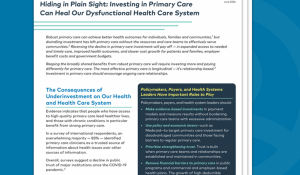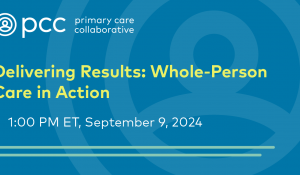You are looking at an archived version of our site. Please visit thepcc.org for a fresh, new experience!
October 2022 Lunch and Learn Discussion
On October 25, 2022, PCC welcomed Dr. Philip Day, UMass Chan Medical School, Dr. Ann-Marie Rosland, University of Pittsburgh, and Dr. Ann O’Malley, Mathematica, to the October Lunch and Learn discussion to present their research and discuss the policy and practice implications.
The two articles discussed included:
- Shakil A, Day PG, Chu J, Woods SB, Bridges K. PedHITSS: A screening tool to detect childhood abuse in clinical settings. Fam Med. 2018:50(10):763-769. doi: 10.22454/FamMed.2018.778329.
- Rosland AM, Wong E, Maciejewski M, et al. Patient-Centered Medical Home Implementation and Improved Chronic Disease Quality: A Longitudinal Observational Study. Health Serv Res. 2018;53(4):2503-2522. doi:10.1111/1475-6773.12805
PedHITSS: A screening tool to detect childhood abuse in clinical settings
Background:
- The national rounded number of children who received a child protective services investigation response or alternative response decreased from 3,476,000 for federal fiscal year (FFY) 2019 to 3,145,000 for FFY 2020.
- Comparing the national number of victims from FFY 2019 (656,000) to the national rounded number of victims in 2020 (618,000) also shows a decrease.
- The FFY 2020 data show three-quarters (76.1%) of victims are neglected, 16.5 percent are physically abused, 9.4 percent are sexually abused, and 0.2 percent are sex trafficked.
- The national estimate of victims who died from abuse and neglect decreased from 1,830 for FFY 2019 to 1,750 for FFY 2020. The rate of child fatalities also decreased from 2.48 per 100,000 children in the population to 2.38 per 100,000 children in the population.
- There is no comprehensive tool that can assess all forms of child abuse and neglect
Source: U.S. Department of Health & Human Services, Administration for Children and Families, Administration on Children, Youth and Families, Children’s Bureau. (2022). Child Maltreatment 2020. Available from https://www.acf.hhs.gov/cb/data-research/child-maltreatment
Summary:
- The goal of the project was to develop a validated, short child abuse screening tool to identify and accurately screen childhood physical and sexual abuse in clinical settings. The Pediatric Hurt, Insult, Threaten, Scream, Sex (PedHITSS) is a 5-item, validated screening tool intended for clinical settings. The tool screens for physical, psychological, verbal, and sexual abuse but not for neglect.
- PedHITSS performs as well as the gold-standard, The Conflict Tactics Scales, Parent-Child Version (CTSPC), but without the complex scoring and time intensiveness
- Limitations: social desirability bias (i.e., a tendency for respondents to respond in a way that is viewed favorably by others), parent/guardian completion, doesn’t assess neglect, and inability to track follow-up of participants
- There was a discussion about how often physicians are threatened over issues of reporting child abuse.
- The hope is that you could use the tool for any patient. It could be another standard screener, regardless of what patient comes into the clinic.
The findings of the study suggest that PedHITSS is a valid and reliable tool to screen for physical, psychological, verbal and sexual abuse in children ages 12 years and under in clinical settings
Patient-Centered Medical Home Implementation and Improved Chronic Disease Quality: A Longitudinal Observational Study
Background
- This study was done as part of the VA healthcare system’s national evaluation of its Patient Centered Medical Home rollout
- The Veterans’ Healthcare System is the largest integrated US health care system. At the time of the study, over 7 million primary care patients were enrolled in the VA, and over 16 million primary care encounters were recorded
Summary
- Research Question: Did VHA primary care clinics with more extensive PCMH implementation have more improvement in chronic disease quality measures?
- Clinics with Patient Aligned Care Teams (PACT) in place by 2012 had significantly larger improvements in more than half of the chronic disease quality measures examined than clinics with the least PACT implementation. If you spread these changes out over 10 million patients, in the VA about 30% have diabetes, a 1% change corresponds to about 300,000 people with diabetes, newly meeting a quality metric
- Dr. Rosland mentioned a recently published study that found integrated mental health services improved physical health outcomes. Leung LB, Rubenstein LV, Jaske E, et al. Association of Integrated Mental Health Services with Physical Health Quality Among VA Primary Care Patients. J Gen Intern Med. 2022;37(13):3331-3337. doi:10.1007/s11606-021-07287-2
- Health systems that invest resources in PCMH and integrated mental health care delivery across all patients could realize downstream improvements in chronic disease quality measures
Ann O’Malley Reaction
- CPC+ is the largest multi-payer medical home model in the US to date. Its goal is to support primary care through enhanced payments, support to practices, and care delivery requirements to enhance access, continuity, coordination, comprehensiveness, care management and population health practices. It's a five year long model, with CMS, commercial payers, and Medicaid.
- Over the first four years of the model there were small improvements in some clinical quality metrics. For example, we found increases in Medicare beneficiaries who received all recommended services for diabetes. In females, we saw increases in breast cancer screening.
Discussion Summary
- Measuring and quantifying the degrees to which practices implement these multifaceted primary care medical home models is tricky. How should we measure primary care quality going forward?
- There was a discussion about how patients were involved in the PCMH implementation.
- There was a discussion about how patient centered medical homes prepared practices for the COVID-19 pandemic.
Senior Fellow, Mathematica
Ann S. O’Malley has over twenty years of experience doing primary care health services research. She conducts both qualitative and quantitative studies with a focus on improving support for primary care practices to provide more coordinated and comprehensive care, particularly for patients with multiple chronic conditions. read more
Associate Professor of Medicine, University of Pittsburgh
Ann-Marie Rosland, MD, MS, is an Associate Professor of Medicine with Tenure at the University of Pittsburgh, and a Research Scientist at the VA Pittsburgh Center for Health Equity Research and Promotion. She is also Director of the Caring for Complex Chronic Conditions Research Center, which is also on Twitter @ComplexCaring.
Dr. Rosland leads health care research and initiatives aiming to:
>Improve health care and self-management support for diabetes and other chronic conditions
>Mobilize the power of patients' social networks to improve health
>Innovate in care management and coordination for complex patients
>Understand impacts of changes in primary care organization and policy
read more
Chief Health Equity Officer/Deputy Chief Health Officer , Merative (formerly IBM Watson Health)
In her role at IBM Watson Health, Dr. Dankwa-Mullan is responsible for the global strategy for driving building clinical evidence for Watson Health solutions. This is accomplished through evaluation research, real-world evidence studies and implementation studies to support evidence-based practices to transform health care. She works with multidisciplinary teams at the interface of big data, cognitive computing and machine learning technology to inform healthcare delivery and clinical decision-making.
read more
Jack Westfall is a family doctor in Washington, D.C. He completed his MD and MPH at the University of Kansas School of Medicine, an internship in hospital medicine in Wichita, Kansas, and his Family Medicine Residency at the University of Colorado Rose Family Medicine Program.
After joining the faculty at the University of Colorado Department of Family Medicine, Dr. Westfall started the High Plains Research Network, a geographic community and practice-based research network in rural and frontier Colorado. He practiced family medicine in several rural communities including Limon, Ft. Morgan, and his hometown of Yuma, Colorado. read more
Associate Director of Education, UMass Medical School
Philip G. Day, PhD is Assistant Professor and Associate Director of Education in the Department of Family Medicine and Community Health at the University of Massachusetts Chan Medical School. A philosopher and applied ethicist by training, Dr. Day focuses on educational research, community-based participatory research, and the intersection of ethics and education in primary care practice. He is currently the co-Chair for the Ethics and Humanities Collaborative for STFM and has served as an Ethics Reviewer for the Environmental Protection Agency since 2020.
read more
What's New
August 16, 2024
- Page 0
- ››









